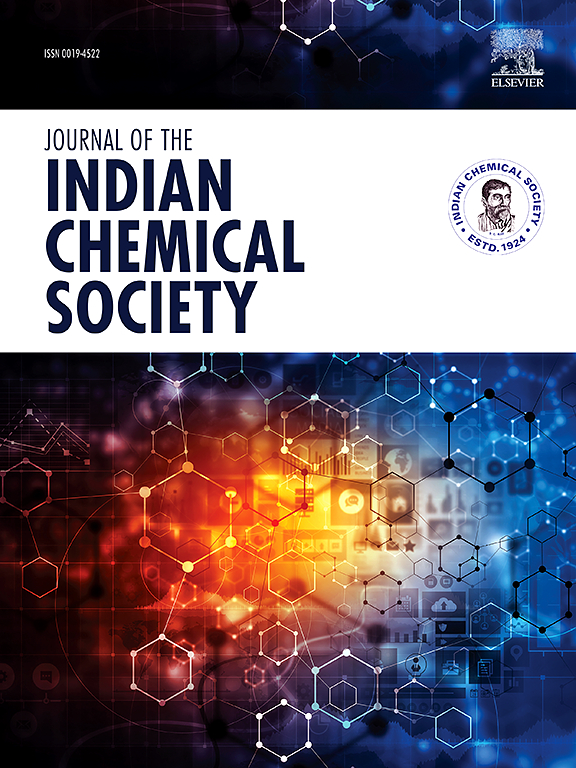Structural, optical, morphological and electrochemical properties of dual-shaped SrTiO3 nanostructures with enhanced photocatalytic and supercapacitor performances
IF 3.2
4区 化学
Q2 CHEMISTRY, MULTIDISCIPLINARY
引用次数: 0
Abstract
The changes in the intermediate products during the photocatalytic degradation of pollutants are particularly important for understanding the degradation mechanism. Herein, we plan a synthesis and characterization of SrTiO3 NPs by performing the hydrothermal method to create high-purity nanomaterials with controlled shapes at low temperature. The structural phase, functional group, optical, morphology, elemental composition and electrochemical properties of SrTiO3 NPs were characterized by X-ray diffraction (XRD), Fourier transform infrared spectroscopy (FT-IR), ultraviolet–visible spectroscopy (UV–Vis), photoluminescence spectroscopy (PL), Field emission scanning electron microscopy (FESEM), energy-dispersive X-ray spectroscopy (EDS or EDAX), cyclic voltammetry (CV), galvanostatic charge-discharge (GCD) and electrochemical impedance spectroscopy (EIS). Based on the XRD characterization, the SrTiO3 NPs have a perovskite nanocrystalline structure with an average particle size of 49.2 nm. FT-IR analysis of the SrTiO3 material showed the metal-oxygen bond (Ti–O) stretching vibrations at 613 cm−1, respectively. UV–visible spectroscopy of the studied material indicated the λmax peak at 315 nm, beside with the band gap (Eg) value of 3.18 eV. Electronic band structures of SrTiO3 NPs have been carried out by performing DFT computations with the hybrid PBE efficient approach. SEM images show the NPs were of cubic perovskite structure with an average crystalline diameter ranging between 50 and 120 nm for the resultant product. The elemental composition mapping of the synthesized material containing Sr, Ti and O elements is confirmed by EDS analysis. The electrochemical process happening in the SrTiO3 sample had been verified by the CV curves, which displayed redox maxima. The formed material's capacitive reactivity and usefulness as electrodes in energy-storing technologies have been shown by GCD scans. The degradation results revealed that SrTiO3 NPs exhibited high photocatalytic activity, degrading 85 % of the Congo red dye as a solution in 120 min at 582 nm when subjected to sunlight. This combined computational and experimental study reveals that SrTiO3 NPs show superior photocatalytic activity, making them vastly effective for environmental remediation and energy technologies, particularly in degrading organic pollutants in wastewater treatment and enabling enable energy conversion.
具有增强光催化和超级电容器性能的双形SrTiO3纳米结构的结构、光学、形态和电化学性质
光催化降解污染物过程中中间产物的变化对理解降解机理尤为重要。在此,我们计划通过水热法在低温下合成和表征SrTiO3 NPs,以获得具有可控形状的高纯度纳米材料。采用x射线衍射(XRD)、傅里叶变换红外光谱(FT-IR)、紫外可见光谱(UV-Vis)、光致发光光谱(PL)、场发射扫描电子显微镜(FESEM)、能量色散x射线光谱(EDS或EDAX)、循环伏安法(CV)、恒流充放电(GCD)和电化学阻抗谱(EIS)。XRD表征表明,合成的SrTiO3纳米粒子具有钙钛矿纳米晶结构,平均粒径为49.2 nm。对SrTiO3材料的FT-IR分析表明,金属-氧键(Ti-O)分别在613 cm−1处拉伸振动。材料的紫外可见光谱在315 nm处有λmax峰,带隙(Eg)值为3.18 eV。采用混合PBE方法对SrTiO3 NPs的电子能带结构进行了DFT计算。SEM图像显示NPs为立方钙钛矿结构,产物平均晶径在50 ~ 120nm之间。通过能谱分析证实了合成材料中含有Sr、Ti和O元素的元素组成图。通过CV曲线验证了SrTiO3样品中发生的电化学过程,并显示出氧化还原最大值。GCD扫描显示了形成的材料的电容反应性和作为储能技术电极的实用性。结果表明,SrTiO3 NPs具有较高的光催化活性,在582 nm的光照下,在120 min内降解85%的刚果红染料。这项计算和实验相结合的研究表明,SrTiO3 NPs具有优异的光催化活性,使其在环境修复和能源技术中非常有效,特别是在废水处理中降解有机污染物和实现能量转换方面。
本文章由计算机程序翻译,如有差异,请以英文原文为准。
求助全文
约1分钟内获得全文
求助全文
来源期刊
CiteScore
3.50
自引率
7.70%
发文量
492
审稿时长
3-8 weeks
期刊介绍:
The Journal of the Indian Chemical Society publishes original, fundamental, theorical, experimental research work of highest quality in all areas of chemistry, biochemistry, medicinal chemistry, electrochemistry, agrochemistry, chemical engineering and technology, food chemistry, environmental chemistry, etc.

 求助内容:
求助内容: 应助结果提醒方式:
应助结果提醒方式:


